Introduction
1. Data sources
Analysis
Selected Findings
1. Incidence
Table 1
| Sites | New cases | Deaths | 10-yr prevalent cases a) | ||||||
|---|---|---|---|---|---|---|---|---|---|
|
|
|
|
|||||||
| Both sexes | Male | Female | Both sexes | Male | Female | Both sexes | Male | Female | |
| All sites | 178,816 | 93,017 | 85,799 | 68,912 | 43,785 | 25,127 | 724,663 | 334,329 | 390,334 |
| Lip, oral cavity, and pharynx | 2,557 | 1,899 | 658 | 969 | 761 | 208 | 11,304 | 7,728 | 3,576 |
| Esophagus | 2,181 | 1,986 | 195 | 1,385 | 1,244 | 141 | 5,216 | 4,717 | 499 |
| Stomach | 28,078 | 18,898 | 9,180 | 10,312 | 6,712 | 3,600 | 134,722 | 89,616 | 45,106 |
| Colon and rectum | 22,623 | 13,536 | 9,087 | 6,802 | 3,809 | 2,993 | 103,033 | 60,448 | 42,585 |
| Liver | 15,663 | 11,776 | 3,887 | 11,292 | 8,512 | 2,780 | 36,036 | 27,085 | 8,951 |
| Gallbladder b) | 4,378 | 2,149 | 2,229 | 3,459 | 1,698 | 1,761 | 9,935 | 5,076 | 4,859 |
| Pancreas | 4,320 | 2,404 | 1,916 | 3,767 | 2,135 | 1,632 | 4,780 | 2,663 | 2,117 |
| Larynx | 1,073 | 998 | 75 | 409 | 364 | 45 | 6,385 | 5,977 | 408 |
| Lung | 18,774 | 13,384 | 5,390 | 14,791 | 10,899 | 3,892 | 34,926 | 23,465 | 11,461 |
| Breast | 12,659 | 75 | 12,584 | 1,731 | 13 | 1,718 | 79,468 | 381 | 79,087 |
| Cervix uteri | 3,888 | - | 3,888 | 954 | - | 954 | 33,102 | - | 33,102 |
| Corpus uteri | 1,562 | - | 1,562 | 210 | - | 210 | 9,084 | - | 9,084 |
| Ovary | 1,816 | - | 1,816 | 834 | - | 834 | 9,732 | - | 9,732 |
| Prostate | 6,471 | 6,471 | - | 1,168 | 1,168 | - | 23,940 | 23,940 | - |
| Testis | 176 | 176 | - | 14 | 14 | - | 1,408 | 1,408 | - |
| Kidney | 3,228 | 2,220 | 1,008 | 655 | 461 | 194 | 15,243 | 10,265 | 4,978 |
| Bladde | 3,230 | 2,582 | 648 | 1,007 | 752 | 255 | 18,260 | 14,845 | 3,415 |
| Brain and CNS | 1,620 | 876 | 744 | 1,040 | 568 | 472 | 6,273 | 3,289 | 2,984 |
| Thyroid | 26,923 | 4,275 | 22,648 | 347 | 108 | 239 | 107,693 | 15,252 | 92,441 |
| Hodgkin lymphoma | 210 | 127 | 83 | 46 | 31 | 15 | 1,253 | 796 | 457 |
| Non-Hodgkin lymphoma | 3,475 | 1,936 | 1,539 | 1,343 | 814 | 529 | 16,142 | 8,873 | 7,269 |
| Multiple myeloma | 893 | 480 | 413 | 615 | 316 | 299 | 2,464 | 1,295 | 1,169 |
| Leukemia | 2,561 | 1,432 | 1,129 | 1,507 | 867 | 640 | 9,936 | 5,442 | 4,494 |
| Other and ill-defined | 10,457 | 5,337 | 5,120 | 4,255 | 2,539 | 1,716 | 44,328 | 21,768 | 22,560 |
CNS, central nervous system. a)10-yr prevalent cases: limited-duration prevalent cases on January 1, 2009. These are patients that were diagnosed between January 1, 1999 and December 31, 2008 and were alive on January 1, 2009. Multiple primary cancer cases were counted multiple times, b)Includes gallbladder and other/unspecified parts of biliary tract.
Table 2
| Sites | Crude incidence rates/100,000 | Age-standardized incidence rates/100,000 a) | ||||
|---|---|---|---|---|---|---|
|
|
|
|||||
| Both sexes | Male | Female | Both sexes | Male | Female | |
| All sites | 361.9 | 375.7 | 348.1 | 271.1 | 318.5 | 245.3 |
| Lip, oral cavity, and pharynx | 5.2 | 7.7 | 2.7 | 3.9 | 6.4 | 1.9 |
| Esophagus | 4.4 | 8.0 | 0.8 | 3.3 | 6.9 | 0.5 |
| Stomach | 56.8 | 76.3 | 37.2 | 42.2 | 63.8 | 24.9 |
| Colon and rectum | 45.8 | 54.7 | 36.9 | 34.1 | 45.9 | 24.7 |
| Liver | 31.7 | 47.6 | 15.8 | 23.7 | 38.9 | 10.5 |
| Gallbladder b) | 8.9 | 8.7 | 9.0 | 6.4 | 7.5 | 5.5 |
| Pancreas | 8.7 | 9.7 | 7.8 | 6.3 | 8.3 | 4.8 |
| Larynx | 2.2 | 4.0 | 0.3 | 1.6 | 3.4 | 0.2 |
| Lung | 38.0 | 54.1 | 21.9 | 27.7 | 46.9 | 13.9 |
| Breast | 25.6 | 0.3 | 51.1 | 18.7 | 0.3 | 36.8 |
| Cervix uteri | 7.9 | - | 15.8 | 5.8 | - | 11.2 |
| Corpus uteri | 3.2 | - | 6.3 | 2.4 | - | 4.6 |
| Ovary | 3.7 | - | 7.4 | 2.8 | - | 5.5 |
| Prostate | 13.1 | 26.1 | - | 9.6 | 23.0 | - |
| Testis | 0.4 | 0.7 | - | 0.4 | 0.7 | - |
| Kidney | 6.5 | 9.0 | 4.1 | 5.0 | 7.4 | 3.0 |
| Bladder | 6.5 | 10.4 | 2.6 | 4.7 | 9.0 | 1.6 |
| Brain and CNS | 3.3 | 3.5 | 3.0 | 2.9 | 3.3 | 2.6 |
| Thyroid | 54.5 | 17.3 | 91.9 | 40.8 | 13.1 | 68.6 |
| Hodgkin lymphoma | 0.4 | 0.5 | 0.3 | 0.4 | 0.5 | 0.3 |
| Non-Hodgkin lymphoma | 7.0 | 7.8 | 6.2 | 5.5 | 6.7 | 4.6 |
| Multiple myeloma | 1.8 | 1.9 | 1.7 | 1.4 | 1.6 | 1.2 |
| Leukemia | 5.2 | 5.8 | 4.6 | 5.0 | 5.7 | 4.3 |
| Other and ill-defined | 21.2 | 21.6 | 20.8 | 16.5 | 19.1 | 4.3 |
2. Mortality
Table 3
| Rank | Cause of deaths | No. of death | Percent of all deaths | Age-standardized death rate a) |
|---|---|---|---|---|
| All causes | 246,113 | 100 | 365.3 | |
| 1 | Cancer | 68,912 | 28 | 101.0 |
| 2 | Cerebrovascular disease | 27,932 | 11.3 | 39.1 |
| 3 | Heart disease | 21,429 | 8.7 | 30.6 |
| 4 | Intentional self harm (suicide) | 12,858 | 5.2 | 20.3 |
| 5 | Diabetes mellitus | 10,234 | 4.2 | 14.5 |
| 6 | Chronic lower respiratory diseases | 7,338 | 3.0 | 10.1 |
| 7 | Transport accidents | 7,287 | 3.0 | 12.1 |
| 8 | Disease of liver | 7,164 | 2.9 | 10.7 |
| 9 | Pneumonia | 5,461 | 2.2 | 7.7 |
| 10 | Hypertensive diseases | 4,724 | 1.9 | 6.6 |
| Others | 72,774 | 29.6 | 112.6 |
Table 4
| Sites | Crude mortality rates/100,000 | Age-standardized mortality rates/100,000 a) | ||||
|---|---|---|---|---|---|---|
|
|
|
|||||
| Both sexes | Male | Female | Both sexes | Male | Female | |
| All sites | 139.5 | 176.9 | 101.9 | 101.0 | 154.1 | 63.5 |
| Lip, oral cavity, and pharynx | 2.0 | 3.1 | 0.8 | 1.4 | 2.6 | 0.5 |
| Esophagus | 2.8 | 5.0 | 0.6 | 2.1 | 4.4 | 0.3 |
| Stomach | 20.9 | 27.1 | 14.6 | 14.8 | 23.5 | 8.7 |
| Colon and rectum | 13.8 | 15.4 | 12.1 | 9.8 | 13.5 | 7.3 |
| Liver | 22.9 | 34.4 | 11.3 | 16.9 | 28.5 | 7.2 |
| Gallbladder b) | 7.0 | 6.9 | 7.1 | 4.9 | 6.1 | 4.1 |
| Pancreas | 7.6 | 8.6 | 6.6 | 5.5 | 7.5 | 4.0 |
| Larynx | 0.8 | 1.5 | 0.2 | 0.6 | 1.3 | 0.1 |
| Lung | 29.9 | 44.0 | 15.8 | 21.3 | 38.7 | 9.4 |
| Breast | 3.5 | 0.1 | 7.0 | 2.6 | 0.0 | 4.9 |
| Cervix uteri | 1.9 | - | 3.9 | 1.4 | - | 2.5 |
| Corpus uteri | 0.4 | - | 0.9 | 0.3 | - | 0.6 |
| Ovary | 1.7 | - | 3.4 | 1.2 | - | 2.3 |
| Prostate | 2.4 | 4.7 | - | 1.6 | 4.6 | - |
| Testis | 0.0 | 0.1 | - | 0.0 | 0.1 | - |
| Kidney | 1.3 | 1.9 | 0.8 | 1.0 | 1.6 | 0.5 |
| Bladder | 2.0 | 3.0 | 1.0 | 1.4 | 2.8 | 0.5 |
| Brain and CNS | 2.1 | 2.3 | 1.9 | 1.7 | 2.0 | 1.4 |
| Thyroid | 0.7 | 0.4 | 1.0 | 0.5 | 0.4 | 0.5 |
| Hodgkin lymphoma | 0.1 | 0.1 | 0.1 | 0.1 | 0.1 | 0.0 |
| Non-Hodgkin lymphoma | 2.7 | 3.3 | 2.1 | 2.0 | 2.8 | 1.4 |
| Multiple myeloma | 1.2 | 1.3 | 1.2 | 0.9 | 1.1 | 0.8 |
| Leukemia | 3.1 | 3.5 | 2.6 | 2.6 | 3.2 | 2.0 |
| Other and ill-defined | 8.6 | 10.3 | 7.0 | 6.3 | 9.1 | 4.4 |
3. Trends in cancer incidence
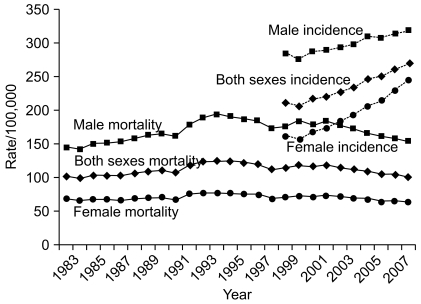 | Fig. 1Annual age-standardized cancer incidence and death rates for all sites by sex during 1983-2008 in Korea. Age-standardization was based on the World Health Organization (WHO) world standard population. |
Table 5
| Sites | Year | APC a) | |||||||||
|---|---|---|---|---|---|---|---|---|---|---|---|
|
|
|||||||||||
| 1999 | 2000 | 2001 | 2002 | 2003 | 2004 | 2005 | 2006 | 2007 | 2008 | ||
| All sites | 210.5 | 205.1 | 216.7 | 220.1 | 227.1 | 234.1 | 246.7 | 250.5 | 260.8 | 271.1 | 3.1 b) |
| Lip, oral cavity, and pharynx | 3.6 | 4.4 | 3.6 | 3.7 | 3.8 | 3.8 | 3.8 | 3.7 | 3.8 | 3.9 | 0.1 |
| Esophagus | 4.1 | 3.7 | 3.9 | 3.8 | 3.6 | 3.5 | 3.5 | 3.4 | 3.3 | 3.3 | -2.1 b) |
| Stomach | 43.6 | 42.3 | 44.0 | 43.6 | 43.2 | 41.1 | 44.3 | 42.7 | 41.6 | 42.2 | -0.3 |
| Colon and rectum | 20.4 | 21.0 | 22.9 | 24.7 | 26.8 | 28.5 | 30.8 | 32.2 | 33.3 | 34.1 | 6.4 b) |
| Liver | 27.9 | 26.7 | 27.3 | 26.5 | 25.7 | 25.5 | 25.8 | 24.5 | 24.2 | 23.7 | -1.7 b) |
| Gallbladder c) | 6.5 | 6.4 | 6.7 | 6.7 | 6.7 | 6.9 | 7.1 | 6.6 | 6.5 | 6.4 | 0.1 |
| Pancreas | 5.6 | 5.5 | 5.5 | 5.8 | 5.8 | 6.0 | 6.3 | 6.1 | 6.3 | 6.3 | 1.7 |
| Larynx | 2.3 | 2.2 | 2.4 | 2.2 | 2.1 | 1.9 | 2.0 | 1.8 | 1.8 | 1.6 | -3.9 b) |
| Lung | 28.5 | 27.7 | 28.3 | 28.5 | 27.8 | 28.7 | 28.9 | 28.6 | 28.2 | 27.7 | 0.0 |
| Breast | 10.7 | 10.8 | 12.7 | 13.9 | 14.2 | 14.9 | 16.1 | 16.8 | 17.9 | 18.7 | 6.5 b) |
| Cervix uteri | 8.5 | 7.9 | 8.3 | 7.7 | 7.4 | 6.8 | 6.5 | 6.3 | 5.7 | 5.8 | -4.6 b) |
| Corpus uteri | 1.4 | 1.3 | 1.5 | 1.7 | 1.9 | 1.9 | 2.0 | 2.1 | 2.1 | 2.4 | 6.0 b) |
| Ovary | 2.7 | 2.5 | 2.5 | 2.6 | 2.7 | 2.7 | 2.8 | 2.8 | 3.0 | 2.8 | 1.6 b) |
| Prostate | 3.1 | 2.7 | 3.6 | 3.9 | 4.8 | 5.9 | 6.3 | 7.2 | 8.5 | 9.6 | 15.2 b) |
| Testis | 0.3 | 0.3 | 0.3 | 0.3 | 0.3 | 0.3 | 0.3 | 0.4 | 0.4 | 0.4 | 3.5 b) |
| Kidney | 3.0 | 2.9 | 3.3 | 3.4 | 3.5 | 3.7 | 4.1 | 4.4 | 4.7 | 5.0 | 6.4 b) |
| Bladder | 4.6 | 4.6 | 4.9 | 4.7 | 5.1 | 5.1 | 5.1 | 4.9 | 4.9 | 4.7 | 0.5 |
| Brain and CNS | 2.9 | 2.8 | 2.8 | 2.6 | 2.9 | 2.9 | 3.1 | 2.9 | 3.1 | 2.9 | 1.0 b) |
| Thyroid | 6.3 | 6.1 | 7.9 | 9.5 | 12.7 | 17.2 | 20.6 | 25.3 | 32.6 | 40.8 | 25.1 b) |
| Hodgkin lymphoma | 0.2 | 0.3 | 0.3 | 0.3 | 0.3 | 0.4 | 0.3 | 0.3 | 0.4 | 0.4 | 4.5 b) |
| Non-Hodgkin lymphoma | 4.5 | 4.2 | 4.5 | 4.6 | 4.9 | 5.2 | 5.3 | 5.5 | 5.5 | 5.5 | 3.3 b) |
| Multiple myeloma | 1.0 | 1.0 | 1.1 | 1.1 | 1.1 | 1.2 | 1.3 | 1.3 | 1.4 | 1.4 | 4.0 b) |
| Leukemia | 4.7 | 4.3 | 4.7 | 4.8 | 4.7 | 4.8 | 4.7 | 4.9 | 4.8 | 5.0 | 0.9 b) |
| Other and ill-defined | 14.3 | 13.5 | 13.9 | 13.5 | 15.1 | 15.1 | 16.0 | 15.9 | 16.8 | 16.5 | - |
Table 7
| Sites | Year | APC a) | |||||||||
|---|---|---|---|---|---|---|---|---|---|---|---|
|
|
|||||||||||
| 1999 | 2000 | 2001 | 2002 | 2003 | 2004 | 2005 | 2006 | 2007 | 2008 | ||
| All sites | 161.1 | 157.4 | 169.0 | 174.6 | 183.8 | 192.8 | 206.7 | 215.0 | 229.7 | 245.3 | 5.1 b) |
| Lip, oral cavity, and pharynx | 1.6 | 2.4 | 1.7 | 1.7 | 1.7 | 1.8 | 1.9 | 1.8 | 1.9 | 1.9 | 0.5 |
| Esophagus | 0.6 | 0.6 | 0.6 | 0.5 | 0.6 | 0.5 | 0.4 | 0.5 | 0.5 | 0.5 | -2.2 b) |
| Stomach | 26.7 | 25.2 | 26.2 | 26.3 | 25.9 | 24.7 | 26.8 | 25.0 | 24.7 | 24.9 | -0.6 |
| Colon and rectum | 16.4 | 16.4 | 17.9 | 18.8 | 20.4 | 21.4 | 22.8 | 23.9 | 24.2 | 24.7 | 5.3 b) |
| Liver | 12.3 | 11.8 | 12.2 | 11.8 | 11.5 | 11.3 | 11.3 | 11.1 | 11.0 | 10.5 | -1.5 b) |
| Gallbladder c) | 5.3 | 5.5 | 5.7 | 5.8 | 5.8 | 5.9 | 6.0 | 5.5 | 5.6 | 5.5 | 0.2 |
| Pancreas | 4.0 | 4.0 | 4.0 | 4.2 | 4.4 | 4.4 | 4.7 | 4.7 | 4.7 | 4.8 | 2.5 b) |
| Larynx | 0.4 | 0.3 | 0.3 | 0.3 | 0.3 | 0.3 | 0.3 | 0.2 | 0.2 | 0.2 | -9.0 b) |
| Lung | 12.4 | 12.5 | 12.3 | 12.6 | 12.4 | 13.0 | 13.5 | 13.9 | 13.8 | 13.9 | 1.5 b) |
| Breast | 20.9 | 20.9 | 24.7 | 27.2 | 27.8 | 29.1 | 31.7 | 33.1 | 35.4 | 36.8 | 6.7 b) |
| Cervix uteri | 16.3 | 15.1 | 15.8 | 14.8 | 14.2 | 13.1 | 12.4 | 12.2 | 11.0 | 11.2 | -4.5 b) |
| Corpus uteri | 2.8 | 2.6 | 3.0 | 3.3 | 3.8 | 3.7 | 3.9 | 4.0 | 4.2 | 4.6 | 6.2 b) |
| Ovary | 5.0 | 4.8 | 4.8 | 5.0 | 5.1 | 5.2 | 5.4 | 5.4 | 5.8 | 5.5 | 1.8 b) |
| Kidney | 1.7 | 1.8 | 1.9 | 2.0 | 2.1 | 2.2 | 2.5 | 2.7 | 2.8 | 3.0 | 6.5 b) |
| Bladder | 1.6 | 1.6 | 1.7 | 1.7 | 1.8 | 1.7 | 1.7 | 1.6 | 1.7 | 1.6 | -0.1 |
| Brain and CNS | 2.6 | 2.5 | 2.5 | 2.4 | 2.5 | 2.7 | 2.8 | 2.7 | 2.8 | 2.6 | 1.0 |
| Thyroid | 10.4 | 10.1 | 13.2 | 16.2 | 21.7 | 29.5 | 35.2 | 43.0 | 55.2 | 68.6 | 25.4 b) |
| Hodgkin lymphoma | 0.1 | 0.2 | 0.2 | 0.2 | 0.2 | 0.2 | 0.2 | 0.3 | 0.3 | 0.3 | 7.1 b) |
| Non-Hodgkin lymphoma | 3.4 | 3.2 | 3.4 | 3.5 | 3.9 | 4.1 | 4.4 | 4.3 | 4.3 | 4.6 | 4.2 b) |
| Multiple myeloma | 0.8 | 0.8 | 0.9 | 0.8 | 1.0 | 1.0 | 1.2 | 1.1 | 1.2 | 1.2 | 5.3 b) |
| Leukemia | 3.9 | 3.8 | 4.1 | 4.0 | 4.1 | 4.1 | 4.0 | 4.3 | 4.1 | 4.3 | 1.1 b) |
| Other and ill-defined | 11.8 | 11.5 | 11.8 | 11.5 | 12.6 | 12.9 | 13.7 | 13.9 | 14.4 | 14.3 | - |
4. Age-specific incidence rates for selected cancer sites
Table 8
| Rank | Age (yr) | |||
|---|---|---|---|---|
|
|
||||
| 0-14 | 15-34 | 35-64 | ≥65 | |
| Males | ||||
| 1 | Leukemia (4.5) | Thyroid (8.2) | Stomach (92.1) | Lung (447.5) |
| 2 | Brain and CNS (2.3) | Leukemia (3.3) | Liver (69.5) | Stomach (443.6) |
| 3 | Non-Hodgkin lymphoma (1.4) | Stomach (2.9) | Colon and rectum (64.5) | Colon and rectum (323.3) |
| 4 | Kidney a) (0.5) | Colon and rectum (2.7) | Lung (41.4) | Prostate (245.3) |
| 5 | Testis a) (0.5) | Non-Hodgkin lymphoma (2.4) | Thyroid (30.0) | Liver (211.6) |
| Females | ||||
| 1 | Leukemia (3.7) | Thyroid (44.5) | Thyroid (166.0) | Colon and rectum (161.9) |
| 2 | Brain and CNS (1.9) | Breast (9.2) | Breast (98.8) | Stomach (154.0) |
| 3 | Non-Hodgkin lymphoma (0.9) | Cervix uteri (5.3) | Stomach (40.9) | Lung (117.7) |
| 4 | Thyroid (0.7) | Stomach (4.4) | Colon and rectum (39.0) | Liver (74.5) |
| 5 | Ovary (0.7) | Ovary (2.7) | Cervix uteri (24.2) | Thyroid (69.3) |
5. Trends in cancer mortality
6. Survival rates
Table 9
| Sites | Total | Male | Female | ||||||||||||
|---|---|---|---|---|---|---|---|---|---|---|---|---|---|---|---|
| 1993-1995 | 1996-2000 | 2001-2005 | 2004-2008 | Change a) | 1993-1995 | 1996-2000 | 2001-2005 | 2004-2008 | Change a) | 1993-1995 | 1996-2000 | 2001-2005 | 2004-2008 | Change a) | |
| All sites | 41.2 | 44.0 | 53.4 | 59.5 | 18.3 | 31.7 | 35.3 | 44.9 | 50.8 | 19.1 | 53.4 | 55.3 | 63.5 | 69.2 | 15.8 |
| Lip, oral cavity, and pharynx | 41.1 | 46.7 | 53.7 | 57.5 | 16.4 | 35.8 | 41.1 | 48.9 | 53.1 | 17.3 | 58.1 | 63.8 | 67.3 | 69.3 | 11.2 |
| Esophagus | 12.7 | 15.2 | 20.7 | 24.7 | 12.0 | 11.8 | 14.3 | 20.0 | 24.0 | 12.2 | 23.7 | 24.2 | 28.4 | 32.2 | 8.5 |
| Stomach | 42.8 | 46.6 | 57.4 | 63.1 | 20.3 | 43.0 | 46.9 | 58.1 | 63.8 | 20.8 | 42.6 | 46.0 | 55.9 | 61.6 | 19.0 |
| Colon and rectum | 54.8 | 58.0 | 66.3 | 70.1 | 15.3 | 55.3 | 59.0 | 68.3 | 72.0 | 16.7 | 54.2 | 56.8 | 63.8 | 67.5 | 13.3 |
| Liver | 10.7 | 13.2 | 19.7 | 23.3 | 12.6 | 9.9 | 12.9 | 19.7 | 23.4 | 13.5 | 13.6 | 14.2 | 19.7 | 22.9 | 9.3 |
| Gallbladder b) | 17.3 | 19.7 | 22.3 | 24.9 | 7.6 | 16.6 | 20.3 | 22.9 | 25.9 | 9.3 | 18.0 | 19.1 | 21.7 | 23.9 | 5.9 |
| Pancreas | 9.4 | 7.6 | 7.5 | 7.6 | -1.8 | 8.8 | 7.3 | 7.5 | 7.3 | -1.5 | 10.1 | 8.1 | 7.5 | 7.9 | -2.2 |
| Larynx | 59.7 | 62.3 | 65.9 | 69.2 | 9.5 | 60.2 | 62.8 | 66.5 | 69.9 | 9.7 | 55.4 | 57.8 | 57.5 | 59.1 | 3.7 |
| Lung | 11.3 | 12.7 | 15.8 | 17.5 | 6.2 | 10.4 | 11.6 | 14.6 | 15.9 | 5.5 | 14.2 | 16.2 | 19.1 | 21.5 | 7.3 |
| Breast | 77.9 | 83.2 | 88.2 | 89.9 | 12.0 | 75.1 | 85.6 | 86.0 | 81.5 | 6.4 | 78.0 | 83.2 | 88.2 | 90.0 | 12.0 |
| Cervix uteri | 77.5 | 80.0 | 81.0 | 80.5 | 3.0 | - | - | - | 77.5 | 80.0 | 81.0 | 80.5 | 3.0 | ||
| Corpus uteri | 81.5 | 81.8 | 84.5 | 84.6 | 3.1 | - | - | - | - | 81.5 | 81.8 | 84.5 | 84.6 | 3.1 | |
| Ovary | 58.7 | 58.9 | 61.0 | 59.9 | 1.2 | - | - | - | - | 58.7 | 58.9 | 61.0 | 59.9 | 1.2 | |
| Prostate | 55.9 | 67.2 | 79.5 | 86.2 | 30.3 | 55.9 | 67.2 | 79.5 | 86.2 | 30.3 | - | - | - | - | - |
| Testis | 85.4 | 90.4 | 90.4 | 91.2 | 5.8 | 85.4 | 90.4 | 90.4 | 91.2 | 5.8 | - | - | - | - | - |
| Kidney | 62.0 | 66.1 | 73.2 | 76.4 | 14.4 | 60.8 | 64.4 | 72.6 | 76.4 | 15.6 | 64.5 | 69.7 | 74.3 | 76.4 | 11.9 |
| Bladder | 69.1 | 73.1 | 75.3 | 76.1 | 7.0 | 70.0 | 74.8 | 77.1 | 77.8 | 7.8 | 65.5 | 66.3 | 68.1 | 68.9 | 3.4 |
| Brain and CNS | 38.5 | 39.0 | 40.4 | 42.0 | 3.5 | 37.2 | 37.5 | 39.7 | 41.3 | 4.1 | 40.2 | 40.7 | 41.1 | 42.7 | 2.5 |
| Thyroid | 94.2 | 94.9 | 98.1 | 99.3 | 5.1 | 87.2 | 89.5 | 95.6 | 98.3 | 11.1 | 95.4 | 95.9 | 98.5 | 99.5 | 4.1 |
| Hodgkin lymphoma | 68.0 | 71.2 | 75.9 | 80.9 | 12.9 | 67.6 | 68.1 | 73.9 | 78.9 | 11.3 | 68.6 | 77.4 | 80.0 | 84.7 | 16.1 |
| Non-Hodgkin lymphoma | 46.6 | 50.8 | 59.6 | 62.8 | 16.2 | 45.3 | 48.9 | 57.7 | 61.0 | 15.7 | 48.7 | 53.5 | 62.1 | 65.0 | 16.3 |
| Multiple myeloma | 22.1 | 19.8 | 28.9 | 33.2 | 11.1 | 21.1 | 17.8 | 29.1 | 33.7 | 12.6 | 23.3 | 22.1 | 28.6 | 32.8 | 9.5 |
| Leukemia | 26.5 | 33.3 | 41.2 | 44.9 | 18.4 | 26.2 | 32.3 | 41.1 | 44.5 | 18.3 | 26.8 | 34.6 | 41.4 | 45.4 | 18.6 |
| Other and ill-defined | 42.1 | 45.9 | 55.0 | 60.4 | 18.3 | 37.4 | 42.4 | 51.4 | 56.3 | 18.9 | 47.4 | 50.0 | 59.1 | 64.9 | 17.5 |
7. Prevalence rates
Table 10
| Sites | Crude mortality rates/100,000 | Age-standardized mortality rates/100,000 a) | ||||
|---|---|---|---|---|---|---|
|
|
|
|||||
| Both sexes | Male | Female | Both sexes | Male | Female | |
| All sites | 1,466.8 | 1,350.4 | 1,583.7 | 1,107.4 | 1,145.0 | 1,136.2 |
| Lip, oral cavity, and pharynx | 22.9 | 31.2 | 14.5 | 17.4 | 25.8 | 10.5 |
| Esophagus | 10.6 | 19.1 | 2.0 | 8.0 | 16.4 | 1.3 |
| Stomach | 272.7 | 362.0 | 183.0 | 203.2 | 302.0 | 123.6 |
| Colon and rectum | 208.5 | 244.2 | 172.8 | 155.1 | 206.1 | 115.8 |
| Liver | 72.9 | 109.4 | 36.3 | 56.0 | 90.2 | 25.9 |
| Gallbladder b) | 20.1 | 20.5 | 19.7 | 14.8 | 17.5 | 12.9 |
| Pancreas | 9.7 | 10.8 | 8.6 | 7.2 | 9.0 | 5.8 |
| Larynx | 12.9 | 24.1 | 1.7 | 9.7 | 20.8 | 1.0 |
| Lung | 70.7 | 94.8 | 46.5 | 52.8 | 81.1 | 31.2 |
| Breast | 160.9 | 1.5 | 320.9 | 118.5 | 1.3 | 232.2 |
| Cervix uteri | 67.0 | - | 134.3 | 49.1 | - | 95.1 |
| Corpus uteri | 18.4 | - | 36.9 | 13.9 | - | 27.2 |
| Ovary | 19.7 | - | 39.5 | 15.4 | - | 30.4 |
| Prostate | 48.5 | 96.7 | - | 34.6 | 86.3 | - |
| Testis | 2.8 | 5.7 | - | 2.6 | 5.2 | - |
| Kidney | 30.9 | 41.5 | 20.2 | 23.9 | 34.2 | 15.0 |
| Bladder | 37.0 | 60.0 | 13.9 | 26.9 | 51.8 | 8.6 |
| Brain and CNS | 12.7 | 13.3 | 12.1 | 11.6 | 12.4 | 10.8 |
| Thyroid | 218.0 | 61.6 | 375.1 | 163.1 | 47.1 | 277.7 |
| Hodgkin lymphoma | 2.5 | 3.2 | 1.9 | 2.2 | 2.8 | 1.7 |
| Non-Hodgkin lymphoma | 32.7 | 35.8 | 29.5 | 26.1 | 30.5 | 22.3 |
| Multiple myeloma | 5.0 | 5.2 | 4.7 | 3.8 | 4.4 | 3.3 |
| Leukemia | 20.1 | 22.0 | 18.2 | 20.0 | 22.0 | 18.1 |
| Other and ill-defined | 89.7 | 87.9 | 91.5 | 71.1 | 78.0 | 65.7 |




 PDF
PDF Citation
Citation Print
Print


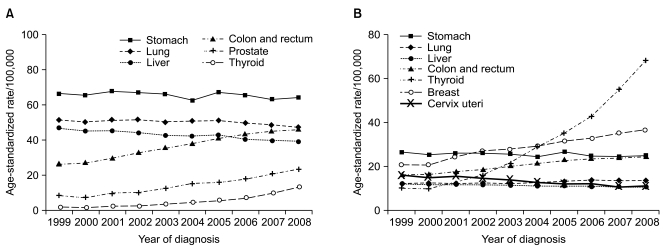
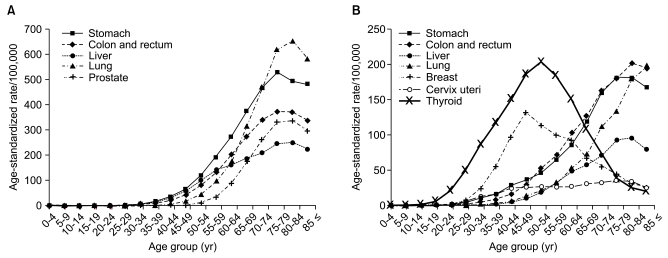
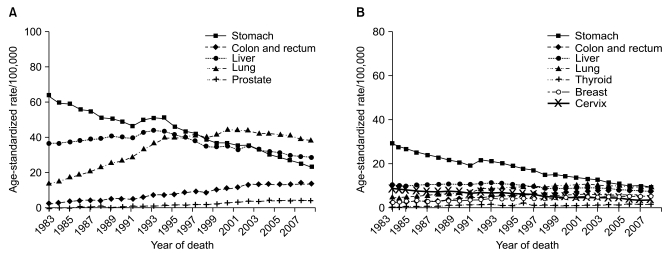
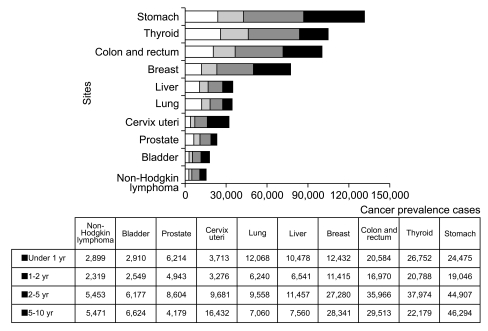
 XML Download
XML Download